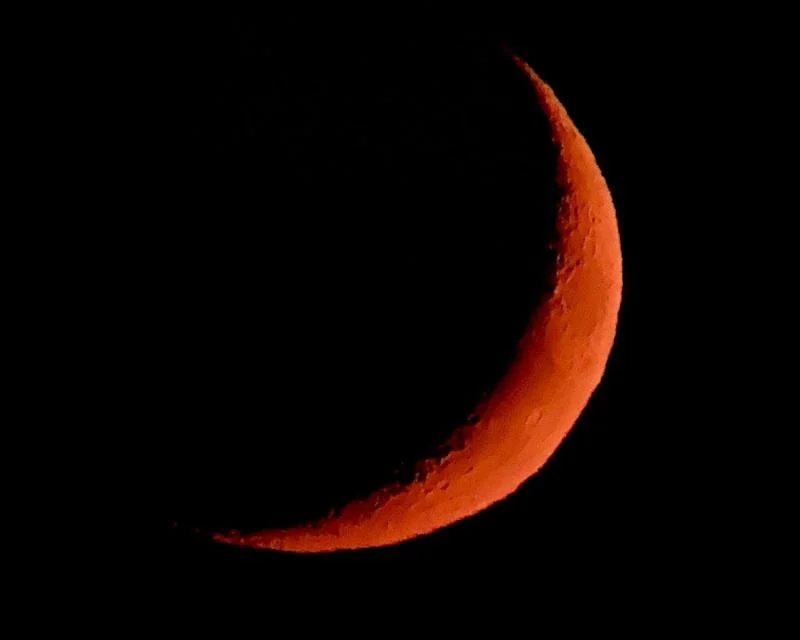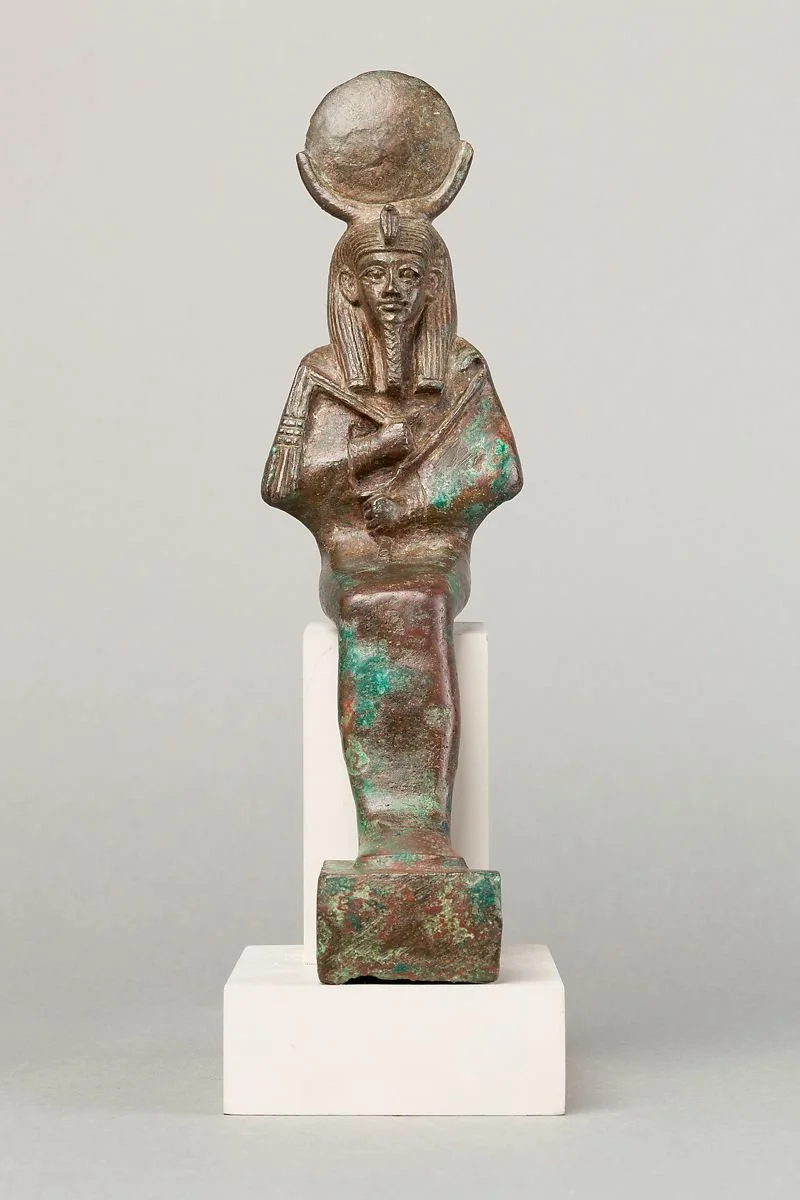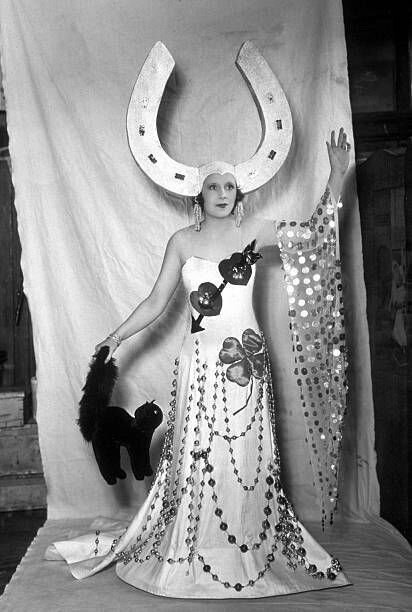Lucky Horseshoes
Most cultures associate horseshoes with good luck, but the origin of this association is the subject of many competing theories. Some theories posit an association between the horseshoe’s crescent shape and the crescent moon or animal horns, both of which are believed to repel evil. Others suggest that it is the horseshoe’s relation to a sacred animal, the horse, that provides its protective power.
The House will focus on the former, more interesting, explanation.
Crescent Moon > Animal Horns > Horseshoe
This progression from crescent moon to animal horns to horseshoe is illustrated in the gallery of images below.
Let’s start with the crescent moon (image 1), which represents the beginning of the moon’s eternal cycling. The word crescent comes from crescere (to increase). Curving delicately around an empty dark space, the crescent offers promise of future fulfillment. Ancient peoples associated the shape with their deities.
In ancient Egypt, Osiris-Iah (image 2) is a form of Osiris specifically linked to the moon, a feature made explicit in this figure through the crown, which represents the moon disk resting on the crescent moon, thereby encompassing the moon in all of its phases. Osiris is linked to the moon because, as the moon changes from crescent to full from month to month, it recalls Osiris’ continual rebirth and regeneration.
Isis — Osiris’s wife and sister — wears a similar crown, which represents the sun between cow horns (image 3). Interestingly, ancient Greeks and Romans (mis)interpreted the crown as a crescent moon. This powerful symbol was worn by Roman women as a safeguard against witchcraft and to prevent the evil spirits of the moon from afflicting them with…lunacy (derived from luna, moon). They also sought to attract the goodwill of Isis (Fortuna) so they would be lucky in matters of the heart and fortunate in life.
Let’s take a step back and see where we are…
We started with the crescent moon, a feature of the natural world. This powerful, two-pronged symmetrical shape, which was used in the ancient world to symbolize both the moon and animal horns, was associated with powerful deities and acquired protective properties.
Incidentally, some draw parallels between Isis and the Virgin Mary (image 4), both of whom would have been perceived as mothers of god and symbols of maternal devotion. Mary is frequently shown standing atop a crescent moon to symbolize her status as queen of heaven.
Given its prominence in depictions of deities, the crescent moon/animal horns shape was a popular motif in jewelry and personal adornment, where it was used for its protective properties. See, for example, the mummy mask (image 5) below, wearing a crescent-shaped pendant called a lunula, from luna (moon) and the animal horns pendant (image 6).
Because the shape of the horseshoe evoked this ancient, sacred symbolism, horseshoes also acquired apotropaic properties and became “lucky”. No one ever explains exactly HOW this happens, it’s just “horseshoes are roughly the same shape so it’s the same thing” and BOOM, you’ve got your talisman.
What do Christians have to say about all this?
You’re right to question the explanation above, dear readers, because the equation “crescent moon = animal horns = horseshoe” is an oversimplification of practices and beliefs that evolved over thousands of years across many cultures.
Let’s explore the Catholic take on why the horseshoe offers protection because they have a much more specific explanation. In this version, St. Dunstan, the patron Saint of Blacksmiths, shoed the devil’s cloven hoof, but did so in a way that caused The Dark Lord great pain and discomfort. As a result of this unpleasantness, Dunstan was able to get Satan to agree never to enter a home with a horseshoe nailed above the door. This is also supposedly the same reason that witches prefer to ride brooms rather than horses. So there you go.
Some folklorists have suggested that it is the material from which the horseshoe is made — rather than its shape — that invests the object with its apotropaic quality. Indeed, iron is used as charm in many cultures dating back to Pliny, who advised that iron coffin nails placed in the lintel of the door could deter nocturnal spirits.
Prongs Up or Prongs Down?
How exactly you’re supposed to hang the horseshoe is the subject of great debate. In one version, the points must face upward so that the shoe collects the luck that falls into it from above. In the other, the points face downward, showering all those who walk under it with good fortune.
The collection of photos below does little to settle this debate, so I will leave you dear, gentle readers with a passage from The Book of Talismans, Amulets & Zodiacal Gems by William Pavitt:
“In Suffolk the fishermen still believe that a horseshoe nailed to the mast of a smack will protect it against bad weather, and their Newfoundland brothers use the horseshoe as a specific against many dangers, especially as a charm to keep away the Devil. In this superstition they resemble the miners of Devon and Cornwall who fix a horseshoe to the mine with the horns upward, it being common knowledge that the Devil travels in a circle and is consequently frustrated in his evil course when he arrives at either of the horns and is obliged to take a retrograde course. To this day, it is still regarded by the country-folk as essential to the well-being of the finder of this charm to suspend its horns upward over the door of his dwelling to hold the luck in, it being thought to run out at each end of the horseshoe if reversed.
“In Gay’s fable of The Old Woman and Her Cats the witch complains:
“…Crowds of boys
Worry me with eternal noise.
Straws laid across my pace retard,
The Horse shoes nailed (each threshold guards).
The stunted broom the Wenches hide
In fear that I should up and ride.”




















